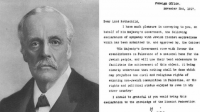A Jewish man stands near some of the 127 graves desecrated by vandals with Nazi swastikas and anti-semitic slogans in the Jewish cemetery of Herrlisheim . (photo credit:REUTERS) How does one effectively fight anti-Semitism and its newest mutation, anti-Israelism? The first step must be to understand how these phenomena are manifested and who is behind them.
Over the past decade as anti-Semitism and anti-Israelism increased exponentially, many books covering the subject have been published. Until now, aside from magisterial works of the late Robert Wistrich and the excellent analysis by Daniel Goldhagen, The Devil That Never Dies: The Rise and Threat of Global Anti-Semitism, there has not been a contemporary review of the global battlefield covering the world’s oldest hatred. There are other valuable studies but they are of limited scope.
Dr. Gerstenfeld served for 12 years as the chairman of the Jerusalem Center for Public Affairs, Israel’s leading think tank. A former international strategic business consultant to some of the world’s largest multinational corporations, Gerstenfeld would today, after the death of Wistrich, be considered the most qualified analyst of contemporary anti-Semitism with a focus on anti-Israelism.
He is a prolific writer and has published 10 books on this subject, including pioneering studies on anti-Semitism on campuses in a variety of countries, the anti-Israelism behind the pseudo-humanitarian mask of the hypocritical Northern European societies, the attitude toward Jews as an indicator of the moral decay of the Netherlands and the increasingly important role that Holocaust inversion and other distortions have assumed in the efforts to demonize the Jewish state.
His new book is a tour de force and undoubtedly his magnum opus. It is a readable, 500-page volume that provides encyclopedic coverage of the subject. It is probably the first book that reviews the delegitimization of Israel as an entity, identifying the motifs employed, the categories of perpetrators, how the hate themes enter society and the extent of damage to Israel and Jews.
Citing a large number of examples from many countries, the central theme of the book highlights the fact that our current struggle is immensely more complex than confronting classical anti-Semitism in which hatred focused on single messages such as the killing of Jesus or genetic inferiority of Jews. Today the onslaught comes from many diverse sources, applies many different motifs and uses a great variety of methods and transmission channels.
His opening chapter is a lucid analysis of how anti-Semites have adopted and integrated anti-Israelism as a new mutation of traditional Jew hatred. The successive chapters discuss how ancient hate motifs have been espoused and upgraded by the current enemies of the Jewish people. Gerstenfeld demonstrates how Muslim anti-Semitism today has effectively adopted the role of Nazi anti-Semitism and is at the forefront of the hatred and violence against Jews – which not only emanates from Muslim countries but from wherever Muslim migrants have settled.
He skillfully illustrates the interfacing and interaction between Muslims in Western countries, politicians, the traditional media, social media activists, nongovernmental organizations, church leaders, academics, trade union leaders, right-wing extremists, social democrats and above all those on the extreme Left, now bolstered by Jewish self-haters, who complete the witches’ brew from which the current onslaught of poisonous anti-Semitism has emerged.
Gerstenfeld demonstrates that anti-Semitism and anti-Israelism use the same core motifs. He cites a variety of studies which indicate that over 150 million European Union citizens believe the Israelis behave like Nazis or seek to exterminate the Palestinians. He systematically exposes the shameless, naked anti-Semitism of the majority of UN representatives. These include the Europeans who are increasingly inclined to either abstain from or vote in favor of outrageous resolutions, often initiated by rogue states, which apply double standards and single out Israel for censure. Gerstenfeld demonstrates that anti-Semitism is not only part of Europe’s history but also its culture. His depiction of a new criminal Europe warrants serious debate.
He also analyzes the impact of the ongoing campaigns of delegitimization on Israel and the ramifications for Diaspora Jews – especially in Europe – who find themselves increasingly discriminated against.
Gerstenfeld outlines his plans to organize the fight on behalf of embattled Israel and the Jewish people. He is strongly convinced that the Israeli government has failed to deal with this problem for decades by mistakenly considering it a minor irritant instead of appreciating the immense consequences of losing the war for the world’s public opinion. He sees a desperate need for the Israeli government to set up an advanced, well-staffed and amply funded anti-propaganda agency which will globally refute the loathsome lies and defamation and humiliate and shame those responsible.
The first task of this agency would be to deal with research, an important component being the creation and updating of a databank of “enemies of Israel and the Jewish people.” Each new incident of hatemongering could thus immediately be linked to their combined past mischief. One would also be able to identify the vulnerabilities of Israel’s enemies.
Gerstenfeld states that many enemies of Israel today enjoy a free anti-Semitic lunch. He suggests that we could, for example, identify some of the academically weakest adherents of the Boycott, Divestment and Sanctions (BDS) movement and expose their professional failures among their university colleagues and in their profession internationally. He claims that it would not even cost much money. As most people are cowards, he believes that many would think twice before joining the BDS movement.
The second activity the anti-propaganda agency would deal with would be the monitoring of new developments concerning hatemongering. His suggestion that this should be done in three different categories is commendable.
The first would be by activity, e.g., calls for violence, Holocaust inversion, BDS, etc. The second would be by perpetrators, such as Muslim states, Muslims in the Western world, media, politicians, liberal churches, NGOs, academics, social democratic parties, trade unions, etc. The third would monitor developments in various countries.
A third department of the proposed anti-propaganda agency would focus on activism, either directly or indirectly. One proposal is that tens of thousands of youngsters willing to defend Israel could be trained to understand how Israel’s enemies work, what lies and fallacies are used and how to expose them. Today the defense of Israel is chaotic. More coordination would enable much more with the same means.
The book includes an introduction by former Spanish prime minister José Maria Aznar, who describes the book as “an excellent contribution to better understanding the indirect attacks against Israel.” It also contains endorsements and commendations from Czech Culture Minister Daniel Herman, former Italian foreign minister Giulio Terzi di Sant’Agata, former Dutch foreign minister Uri Rosenthal, former Swedish development cooperation minister Alf Svensson, former US ambassador to the United Nations John Bolton and others. This book should be considered a compulsory manual for anyone engaged in public activity to promote the case for Israel or combat anti-Semitism.
The author’s website can be viewed at www.wordfromjerusalem.
com. He may be contacted at ileibler@leibler.com.






















